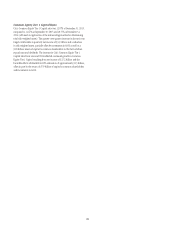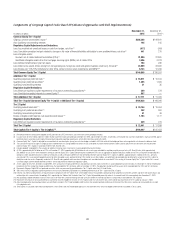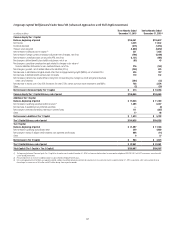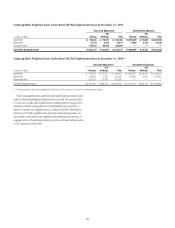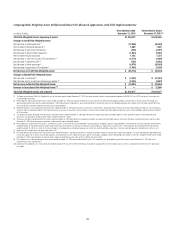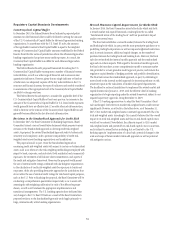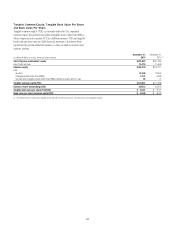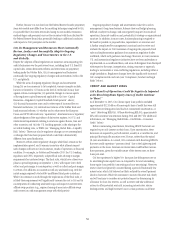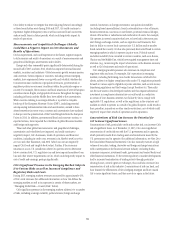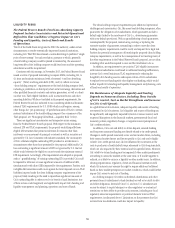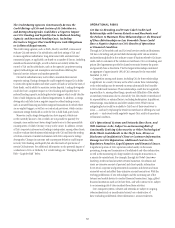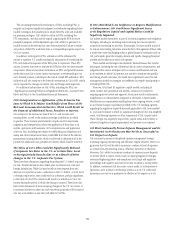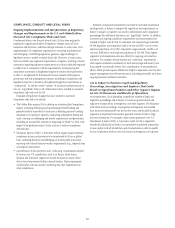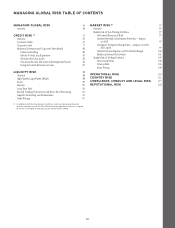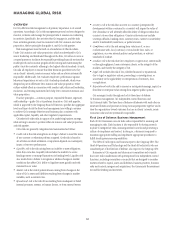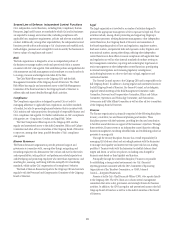Citibank 2015 Annual Report Download - page 73
Download and view the complete annual report
Please find page 73 of the 2015 Citibank annual report below. You can navigate through the pages in the report by either clicking on the pages listed below, or by using the keyword search tool below to find specific information within the annual report.55
Citi’s ability to reduce or mitigate this reset risk going forward. Accordingly,
as these loans further reset during 2016 and 2017, Citi could continue to
experience higher delinquency rates as well as increased loan loss reserves
and net credit losses in future periods, which could negatively impact its
results of operations.
Macroeconomic and Geopolitical Challenges Globally
Could Have a Negative Impact on Citi’s Businesses and
Results of Operations.
Citi has experienced, and could experience in the future, negative impacts
to its businesses and results of operations as a result of macroeconomic and
geopolitical challenges, uncertainties and volatility.
Energy and other commodity prices significantly deteriorated during the
second half of 2015 and into 2016, which has impacted various financial
markets, countries and industries. Global economic growth remains uneven
and uncertain. Various regions or countries, including certain emerging
markets, have experienced slower or no growth and volatility, whether due
to macroeconomic conditions or geopolitical tensions, governmental or
regulatory policies or economic conditions within the particular region or
country. For example, the economic and fiscal situations of several European
countries remain fragile, and geopolitical tensions throughout the region,
including in Russia and the Middle East, have added to the uncertainties.
While concerns relating to sovereign defaults or a partial or complete
break-up of the European Monetary Union (EMU), including potential
accompanying redenomination risks and uncertainties, seemed to have
abated somewhat in recent years, concerns and uncertainties have surfaced
in Europe over the potential exit of the United Kingdom from the European
Union in 2016. In addition, governmental fiscal and monetary actions, or
expected actions, have impacted the volatilities of global financial markets
and foreign exchange rates.
These and other global macroeconomic and geopolitical challenges,
uncertainties and volatilities have impacted, and could continue to
negatively impact, Citi’s businesses, results of operations and financial
condition, including its credit costs, revenues in its Markets and securities
services and other businesses, and AOCI (which can in turn negatively
impact Citi’s book and tangible book value). Further, if the economic
situation in a non-U.S. jurisdiction where Citi operates were to deteriorate
below a certain level, U.S. regulators can and have imposed mandatory loan
loss and other reserve requirements on Citi, which could negatively impact its
cost of credit and earnings, perhaps significantly.
Citi’s Significant Presence in the Emerging Markets Subjects
It to Various Risks as well as Increased Compliance and
Regulatory Risks and Costs.
During 2015, emerging markets revenues accounted for approximately 41%
of Citi’s total revenues (for additional information on how Citi defines the
emerging markets as well as its exposures in certain of these markets, see
“Managing Global Risk—Country Risk” below).
Citi’s significant presence in the emerging markets subjects it to a number
of risks, including sovereign volatility, political events, foreign exchange
controls, limitations on foreign investment, sociopolitical instability
(including from hyper-inflation), fraud, nationalization or loss of licenses,
business restrictions, sanctions or asset freezes, potential criminal charges,
closure of branches or subsidiaries and confiscation of assets. For example,
Citi operates in several countries that have, or have had in the recent past,
strict foreign exchange controls, such as Argentina and Venezuela, that
limit its ability to convert local currency into U.S. dollars and/or transfer
funds outside the country. Citi has also previously discovered fraud in certain
emerging markets in which it operates in prior years. Political turmoil
and other instability have occurred in certain countries, such as in Russia,
Ukraine and the Middle East, which have required management time and
attention (e.g., monitoring the impact of sanctions on the Russian economy
as well as Citi’s businesses and results of operations).
Citi’s emerging markets presence also increases its compliance and
regulatory risks and costs. For example, Citi’s operations in emerging
markets, including facilitating cross-border transactions on behalf of its
clients, subject it to higher compliance risks under U.S. regulations primarily
focused on various aspects of global corporate activities, such as anti-money-
laundering regulations and the Foreign Corrupt Practices Act. These risks
can be more acute in less developed markets and thus require substantial
investment in compliance infrastructure or could result in a reduction
in certain of Citi’s business activities. Any failure by Citi to comply with
applicable U.S. regulations, as well as the regulations in the countries and
markets in which it operates as a result of its global footprint, could result in
fines, penalties, injunctions or other similar restrictions, any of which could
negatively impact Citi’s results of operations and its reputation.
Concentrations of Risk Can Increase the Potential for
Citi to Incur Significant Losses.
Concentrations of risk, particularly credit and market risk, can increase Citi’s
risk of significant losses. As of December 31, 2015, Citi’s most significant
concentration of credit risk was with the U.S. government and its agencies,
which primarily results from trading assets and investments issued by the
U.S. government and its agencies (for additional information, see Note 24 to
the Consolidated Financial Statements). Citi also routinely executes a high
volume of securities, trading, derivative and foreign exchange transactions
with counterparties in the financial services industry, including banks,
insurance companies, investment banks, government and central banks and
other financial institutions. To the extent regulatory or market developments
lead to increased centralization of trading activity through particular
clearing houses, central agents or exchanges, this could also increase Citi’s
concentration of risk in this industry. Concentrations of risk can limit, and
have limited, the effectiveness of Citi’s hedging strategies and have caused
Citi to incur significant losses, and they may do so again in the future.


